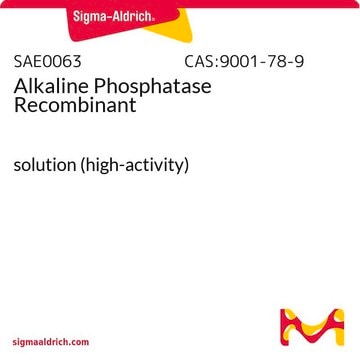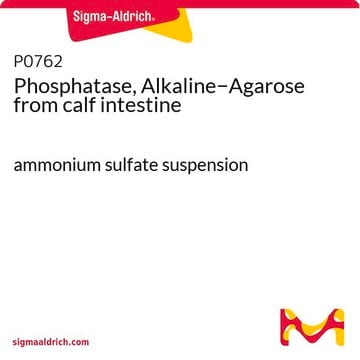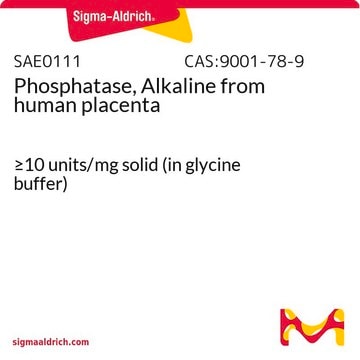03359123001
Roche
Alkaline Phosphatase recombinant, highly active
EIA Grade, from Pichia Pastoris
Sign Into View Organizational & Contract Pricing
All Photos(1)
About This Item
Recommended Products
Quality Level
Assay
≥95% (HPLC)
form
buffered aqueous solution (ready-to-use, 20 mg/ml)
specific activity
≥7000 units/mg protein (At 37 °C with pNPP and DEA as the substrates)
packaging
pkg of 10 mg (500 μl)
manufacturer/tradename
Roche
concentration
20 mg/mL (ready-to-use)
optimum pH
8.0(Stability)
9.8(Activity)
shipped in
wet ice
storage temp.
2-8°C
General description
Alkaline phosphatase (ALP) is a hydrolase enzyme. It is a highly active form in calf intestinal mucosa. The calf intestinal alkaline phosphatase is a dimeric glycoprotein with a molecular weight of about 140kDa.
The recombinant, highly active Alkaline Phosphatase possesses the same amino acid sequence as the native, bovine-sourced Alkaline Phosphatase. No animal-derived components are used in the production process. This eliminates the risk of Bovine Spongiform Encephalopathy (BSE) and other infections caused by animals.
The recombinant enzyme guarantees superior lot-to-lot consistency and completely eliminates the risk of BSE.
The recombinant enzyme guarantees superior lot-to-lot consistency and completely eliminates the risk of BSE.
Specificity
Alkaline phosphatase catalyzed the hydrolysis of numerous phosphate esters, such as esters of primary and secondary alcohols, saccarides, cyclic alcohols, phenols and amines. Phosphodiesters do not react. The enzyme hydrolyzes inorganic pyrophosphate. The kinetic properties of the enzyme depend on many factors, such as enzyme purity, enzyme concentration in the assay, buffer, pH etc.
Application
Alkaline Phosphatase can be coupled to other proteins via its amino and carbohydrate groups. The enzyme solution can be used directly for conjugation without prior dialysis. For conjugation of AP with IgG, a ration of 2.5:1 is recommended. The application of the conjugated enzyme varies from ELISAs and microarrays to western blot analysis.
Biochem/physiol Actions
Alkaline phosphatase (ALP) is responsible for removing phosphate groups at the 5- and 3- positions from many types of molecules, such as nucleotides, proteins, and alkaloids. It can also modify lipopolysaccharides by dephosphorylation of the lipid A moiety, thereby making it less toxic than the unmodified lipid A.
Specifications
≥7,000 U/mg (+37°C; pNPP; DEA)
Physical form
Solution in 3 M NaCl, pH 7.6, 5 mM magnesium chloride, 0.1 mM zinc chloride, 30 mM triethanolamine.
Preparation Note
Activator: Mg2-, Co2- and Mn2-ions
Other Notes
For life science research only. Not for use in diagnostic procedures.
Storage Class Code
12 - Non Combustible Liquids
WGK
WGK 1
Flash Point(F)
No data available
Flash Point(C)
No data available
Certificates of Analysis (COA)
Search for Certificates of Analysis (COA) by entering the products Lot/Batch Number. Lot and Batch Numbers can be found on a product’s label following the words ‘Lot’ or ‘Batch’.
Already Own This Product?
Find documentation for the products that you have recently purchased in the Document Library.
Customers Also Viewed
Affinity-chromatography purification of alkaline phosphatase from calf intestine.
Brenna O, et al.
The Biochemical Journal, 291-6 null
Intestinal alkaline phosphatase detoxifies lipopolysaccharide and prevents inflammation in zebrafish in response to the gut microbiota.
Bates JM, et al.
Cell host & microbe, 371-82 null
Joanna Hajduk et al.
mAbs, 12(1), 1736975-1736975 (2020-03-14)
Minor changes in the quality of biologically manufactured monoclonal antibodies (mAbs) can affect their bioactivity and efficacy. One of the most important variations concerns the N-glycosylation pattern, which directly affects an anti-tumor mechanism called antibody-dependent cell-meditated cytotoxicity (ADCC). Thus, careful
Quantitation of surface coverage of oligonucleotides bound to chip surfaces: a fluorescence-based approach using alkaline phosphatase digestion.
Pal S, et al.
Lab on a chip, 1332-41 null
Yuta Kyosei et al.
Diagnostics (Basel, Switzerland), 10(8) (2020-08-23)
Polymerase chain reaction (PCR)-based antigen tests are technically difficult, time-consuming, and expensive, and may produce false negative results requiring follow-up confirmation with computed tomography. The global coronavirus disease 2019 (COVID-19) pandemic has increased the demand for accurate, easy-to-use, rapid, and
Our team of scientists has experience in all areas of research including Life Science, Material Science, Chemical Synthesis, Chromatography, Analytical and many others.
Contact Technical Service







